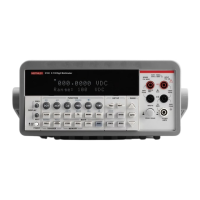Optimizing measurement speed
The configurations listed below assume that the multimeter has had factory setups restored.
DC voltage, DC current, and resistance:
Select 3
½
digits, 0.01 PLC, filter OFF, fixed range.
AC voltage and AC current:
Select 3
½
digits, 0.01 PLC, filter OFF, fixed range.
Temperature:
• Select 3
½
digits, 0.01 PLC, filter OFF.
For all functions, turn off the display and autozero and set the trigger delay to zero. Use the
:SAMPle:COUNt and READ? bus commands.
Specifications A-11

